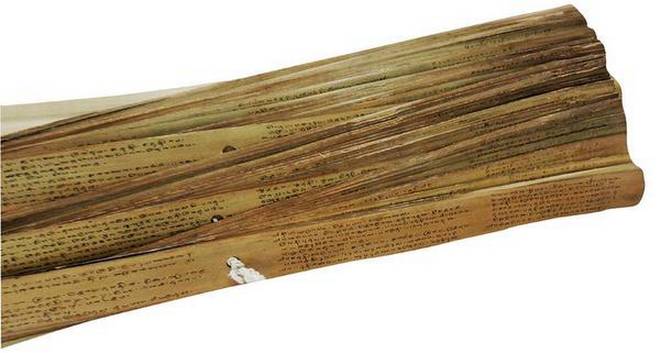
Palm leaf manuscripts reveal a history of slavery in Nanjil Nadu, now part of Kanniyakumari district
“The severe drought has left us with nothing, not even gruel. Our legs and calf muscles have become swollen and we are not able to walk. So as suggested by the head of our family, we sold ourselves to Raman Iyappan.”
A 1459 palm leaf manuscript faithfully records the grim story of a Kerala Samban magan, Avayan, his nephew Thadiyan and his sister Nalli, in the note prepared for their sale as slaves.
The lush green fields of Nanjil Nadu, the rice bowl of erstwhile South Travancore and now part of Kanniyakumari district of Tamil Nadu, hide a history that cut across the social spectrum. Slavery was common in the region as recently as 200 years ago.
Interestingly, while members of the Vellalas, a land holding community that wielded enormous influence during the reign of the Travancore kings, were sold as slaves, Dalits, who were also often sold as slaves, also owned land.
A collection of 19 palm leaf manuscripts, part of the so-called Mudaliar Olaigal, reveals details of the practice. Written in Tamil script, the language of the manuscripts is mixture of Malayalam and Tamil, reflecting the composite culture of the region.
“A manuscript recorded in 1601 that records the sale of land by two Dalits — Avaiathan and Konathan, who belong to the Pallar community — proves the claim that Dalits also owned lands,” said folklorist A.K. Perumal, who has translated and edited Mudaliar Olaigal, published by Kalachuvadu.
The term ‘Mudaliar’ refers to the head of the family in Azhagiyapandiapuram in Kanniyakumari district. The community of Saiva Vellalas were conferred the title ‘Mudaliar’ by the Travancore kings and they ruled Nanjil Nadu on behalf of the kings.
Late poet Kavimani Desigavinayagam Pillai copied a few manuscripts in 1903. In addition to records on slave auctions, they contain a wealth of detail on the revenue system, maintenance of irrigation tanks and rivers and professions of many communities.
Chronicling a reality very different from the present, the manuscripts speak of wealthy Dalits.
A manuscript from 1462 says one Sundarapandian Chetti borrowed four ‘kaliyuga Raman panam’ (money used in that period), from one Kesavan of ‘sambavar’ caste, a sub-sect of Dalits. A 1484 manuscript, when referring to the border of a piece of land, says it lies “south of [the property of] Perumparaian”, a big land owner from the community.
Women punished
“But in the case of Vellalas, the women sold as slaves were used as maids in their owners’ houses. Only a Vellala was allowed to own another member of his community as a slave and this was openly announced before the commencement of an auction,” said Dr. Perumal.
The women slaves from the Vellalas were known as ‘Vellatti’. According to the Madras University Lexicon, ‘Vellati’ means a servant maid or slave.
“Slaves from the upper caste were clearly differentiated from Dalit slaves. Vellattis were used for the housekeeping,” explains said Dr. Perumal, who collected the manuscripts from the Thiruvananthapuram archives.
Women from upper castes were often sold as slaves after they were found to have had relationships with men from lower castes.
Dr. Perumal said slave markets existed in Aloor ( present day Kalkulam taluk), Aralvaimozhi, Thazhakudi (Thovalam taluk) and Rajakkamangalam (Agastheeswaram taluk).
K.K. Kusuman, who has studied the history of slavery in Travancore, had recorded that the price of a slave depended on the social hierarchy.
The manuscripts contain records of the prices fixed for slaves. In the records, the caste of a slave is used as a prefix unlike the modern day practice in which a caste title is used as a suffix.
Dr. Perumal said poverty was the reason for slavery.
A 1458 manuscript records a slave as saying: “We sold ourselves because of poverty.” Another one, recorded in 1472, records the poignant story of a man pledging himself and his daughter as he was unable to repay a loan and interest due on it. Subsequently he is recorded as having become a permanent slave.
Slavery was abolished in Travancore on July 18, 1853 by a declaration made by the King Uthiram Thirunal.
source: http://www.thehindu.com / The Hindu / Home> News> States> Tamil Nadu / by B. Kolappan / Chennai – May 08th, 2017